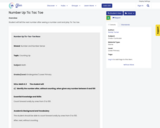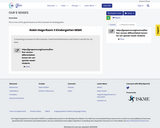
Student will tell the next number after seeing a number card and play Tic Tac toe.
- Subject:
- Cross-Curricular
- Material Type:
- Game
- Author:
- Sandy Turner
- Date Added:
- 05/20/2022

Student will tell the next number after seeing a number card and play Tic Tac toe.

This is one of the great lessons on the 5 senses for kindergarten.

Learn the meaning of "One Health." One Health is a concept that connects the health of animals, people, and the environment. Each aspect is equal, important, and delicately intertwined. In this episode, Wildlife Center veterinary and rehabilitation staff, along with public health officials, explain One Health concepts and challenges and highlight how we can work together for the optimal health of all.

Students will be able to define sextortion, explain
common tactics and threats used by extorters,
learn how to avoid being sextorted online, and
outline options available to victims of sextortion.

This is a resource that describes the 5 Ws of Online Enticement.

Under Quick Links, listed resources for parents, students, and staff for Fall 2020 return to school.

Students will engage in a discussion about the concepts of algorithms and loops. They will then apply the pair programming technique to collaboratively create an origami model. During the activity, students will closely examine the algorithm, represented by the origami instructions, and identify the 'loops,' ( steps that are repeated in these instructions).

Students will engage in a discussion about the concepts of algorithms and loops. They will then apply the pair programming technique to collaboratively create an origami model. During the activity, students will closely examine the algorithm, represented by the origami instructions, and identify the 'loops,' ( steps that are repeated in these instructions).

Want to introduce some basic coding and real life examples of the Scientific Method? This is the lesson for you. Using either the online program MakeCode, or by purchasing the Handheld Kitronik Arcades, the students will be performing an experiment while coding a maze game. No purchases required if students only use the online platform. A whole lesson ready to engage your students and use Computer Science and the Scientific Method!

Students will learn about abstraction by examining a model computer and then breaking down several medieval romances into their essential components.

Scientific Method and scientific investigation are skills needed for our students to explore new adventures and avenues. Kids will have a good time exploring science while dissolving marshmallows. Students will be investigating how temperature affects the size of a marshmallow. The students will determine the constant, dependent variable, and independent variable.

Students will be immersed in a part of each of the 5 ancient civilizations and learn about either architecture or daily life using a VR headset and Youtube App.

In this project, You will compare homemade applesauce and store bought applesauce. We’ll look at the cost, nutritional information and taste of each option. You’ll make your own applesauce, test different brands, and then use simple programming to analyze and visualize the data. By the end you will be able to decide which option is healthier, more affordable and tastier!

This activity incorporates a lesson on online safety with a whole-class review of astronomy. Students will review what is personal vs public information and the dangers of posting private information online. Then they will go around the room to examine astronomy posters. They’ll be hunting for personal details that WOULD NOT be safe for an individual to include in a public forum, like posters or online. They’ll also be looking for key ideas that they covered during their astronomy course.

Students break down a large task into smaller pieces in this lesson about Wars from 1500.

In this lesson we will discuss the story of The Three Little Pigs and the types of houses that they built. Which ones were stronger and why? How do people protect themselves? In Ancient China they used a wall. Did that wall protect them? How? What are other ways people protect themselves? In today’s world we need to protect ourselves using strong passwords. How do we make a strong password? Today you will build a strong password. Then you will build a great wall that is as strong as the password that you created!

We all know that students can retain more knowledge when they have something concrete for it to stick to, why not actually build something that they can build their knowledge upon? Using the MakeDo kits and the stencils that come in this lesson. Let students take some cardboard that is just waiting to be recycled and upcycle it into the Rome Colosseum!!

Looking for a fun way to teach both scientific method and cybersecurity? Well great job, you found it. Students will not only learn 5 characteristics to making a good password but they will also be using all of their 2.1, 3.1, and 4.1 strands to build and rebuild a structure using different materials that are probably inside your classroom right now. Need a STEM activity for a club day? Need a “Friday and I can’t teach anymore content” lesson? This is for you. Roll up your sleeves and let the students do the work and problem solve in a simple and fun way.

Can you see how far you can catapult a Pom Pom? I want to see! We are going to be building a catapult from scratch. Your goal is to see if you can catapult your Pom Pom at least 3 feet.

Students will be learning about the importance of building strong passwords! It's great that they will be able to see the real-world application of this concept through building pyramids like the ancient Egyptians. It's interesting to note how using different materials can determine the strength of a pyramid, just like how using different characters, symbols, and numbers can determine the strength of a password. This is a fun and engaging way for students to learn about cybersecurity.